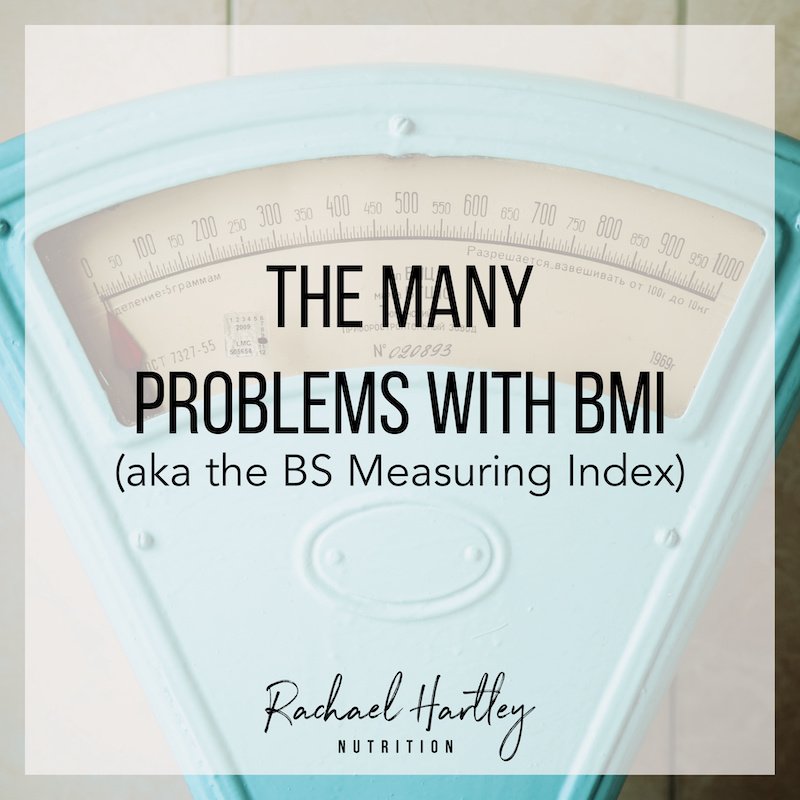The MANY Problems with BMI - aka The BS Measuring Index
BMI charts are as ubiquitous to doctors offices as stethoscopes and thermometers, a crude formula that categorizes people into categories based on weight. Most people recognize the BMI scale has problems, but most don’t realize just how bunk BMI actually is. Learn about the problems with BMI, and why we should stop using this metric to measure health.
BMI charts are as ubiquitous to doctors offices as stethoscopes and thermometers. Developed as a formula to measure the ratio of weight to height, over the past 50 years BMI has somehow become a proxy for measuring health. By sorting people into categories of underweight, normal, overweight, obese, and morbidly obese, the BMI chart asserts we can assume ones risk of death and chronic disease, or in the case of “obesity,” diagnoses people with an illness based on their body size.
While use of the BMI scale is extremely common (as is the belief that weight equals health), anyone with some degree of education in weight science will admit there are many problems with BMI. Even before my practice aligned with Health at Every Size, I thought BMI was 90% useless.
Still, I don’t think people realize quite how bunk the BMI scale actually is. Shout out to whoever started that BMI = BS Measuring Index on IG, because I think that’s the most accurate description I’ve heard (if you know please tell me so I can give credit!). While there may be limited use for BMI in research, there is ZERO use for BMI in assigning or predicting health. Read on to learn why you should stop using and paying attention to BMI…
The MANY Problems with BMI
BMI wasn’t designed for use on individuals.
Today, BMI is used to assign health risks to individuals, or to recommend a “healthy” weight. However when it was created in the mid-1800s (by a mathematician and astronomer, not a doctor), it was designed as a tool to measure to measure the average weight of a population. Adolphe Quetelet, the creator himself, stated that it was not for use on individuals, and it was most certainly not designed to measure health. Quetelet, who was a pre-eugenicist (yikes), wanted to identify the average man, because pre-eugenicists were interested in things like that.
Not only was the BMI formula not developed for use on individuals, but the populations measured in its development were in no way representative of the diverse populations it’s being used on today. Quetelet developed BMI using a group of all young, white men. It’s for this reason that BMI is less accurate for women and people of color.
BMI doesn’t distinguish between different types of body mass.
One of the problems with BMI is that it doesn’t distinguish between fat, muscle, skeletal tissue, or fluid weight. Having a greater percentage of muscle and denser bones are both associated with fitness and good health, however these tissues are heavier and can make one’s BMI higher. One of the common critiques of BMI is that athletes who appear to be specimens of health, like LeBron James or Tom Brady, have BMI’s that categorize them in the “overweight'“ or “obese” range. That means that technically, these athletes are considered to have a “disease” as a result of their weight. I’ll note, this is a pretty clear example of the problems with BMI for those who are unfamiliar with its shortcomings because these athletes meet our societal view of what fitness/health looks like. However, there are also plenty of athletes in fat bodies who are also extremely fit, like Olympic gold-medalist Sarah Robles or ultra-marathoner Mirna Valerio.
Having a BMI that’s “overweight/obese” does not mean one is unhealthy.
Ostensibly, the point of using BMI is to predict health risk. However, research is pretty clear that weight is not a proxy for health. In one of the largest studies to examine the relationship between weight and health, epidemiologist Katherine Flegal examined data from hundreds of thousands of people and found that people in the “overweight” category actually had the lowest risk of death. People whose BMI was between 30-34.9 (“class 1 obesity”) have the same mortality risk as those who are in the “normal” weight category.
For all the talk about the health risks of “obesity,” would you know that the highest risk of death is actually in the underweight category? Yet you don’t see multimillion dollar public health campaigns focused on trying to get people to gain weight, do you?
While there is a correlation between higher BMIs (>35) and risk of certain chronic diseases, correlation is not causation, and it still doesn’t mean it’s valid to diagnose everyone with a higher BMI as having a disease (i.e. “obesity). Research shows one third of people classified as “obese” would be classified as “healthy” using actual cardiometabolic indicators, while nearly one third of people in the “normal” weight BMI category would be classified as “unhealthy.”
The BMI equation itself is kinda screwy.
BMI is calculated by dividing weight by height squared. The mathematician who came up with the formula decided to square height instead of cubing it in order to make his data work, as the original formula didn’t yield a bell curve. Forcing your data to fit your hypothesis by changing equations is not great science! The change means that the current BMI formula is for two-dimensional instead of three-dimensional humans.
Focusing on BMI ignores behaviors.
The argument for using BMI is that it’s a quick, easy, and inexpensive tool for assessing a (supposedly) modifiable risk factor. But you know what else is a pretty quick way of assessing modifiable risk factors? Asking about just four behaviors - fruit and vegetable consumption, physical activity, smoking, and alcohol use. Research has shown that people with BMIs >30 who eat 5 or more fruits and vegetables daily, get regular exercise, limit alcohol use and don’t smoke have the same mortality risk as people in the “normal” BMI category. Can you imagine what visits to the doctor would be like if they screened for these things on intake instead of taking weights, and provided resources for those who were interested in making changes?
Fat isn’t a disease. It’s a naturally existing body size.
Bodies exist in a wide range of shapes and sizes - curvy, thin, plus sized, skinny, fat, straight-sized, very fat, medium, large - there’s many different descriptors people like to use. Assigning a disease (i.e. obesity) to a body size that naturally exists, and still would even if every single person was eating healthfully and exercising regularly, is dehumanizing and promotes stigmatizing treatment and institutional policies in healthcare.
Have you been told to lose weight for health?
If so, I’m sorry that you were given lazy medicine. It’s really unfair to you, because weight is not something entirely in our control - nor is health for that matter. Hinging health to weight distracts from actual treatments and positive behaviors that can promote better health. In my practice, we’re committed to providing weight inclusive care, which means focusing on your behaviors with food, and relationship to it - NOT an arbitrary number on a scale. Learn more about our practice here, and contact us to see if we’re a good fit to work together.
Additional reading on the problems with BMI:
The Racist History of the BMI by Aubrey Gordon
Why BMI is a Big Fat Scam by Kiera Butler
How Obesity Became a Disease by Harriet Brown
This post on the problems with BMI was originally posted Feb 2019 and has been updated to give you the best possible content.





